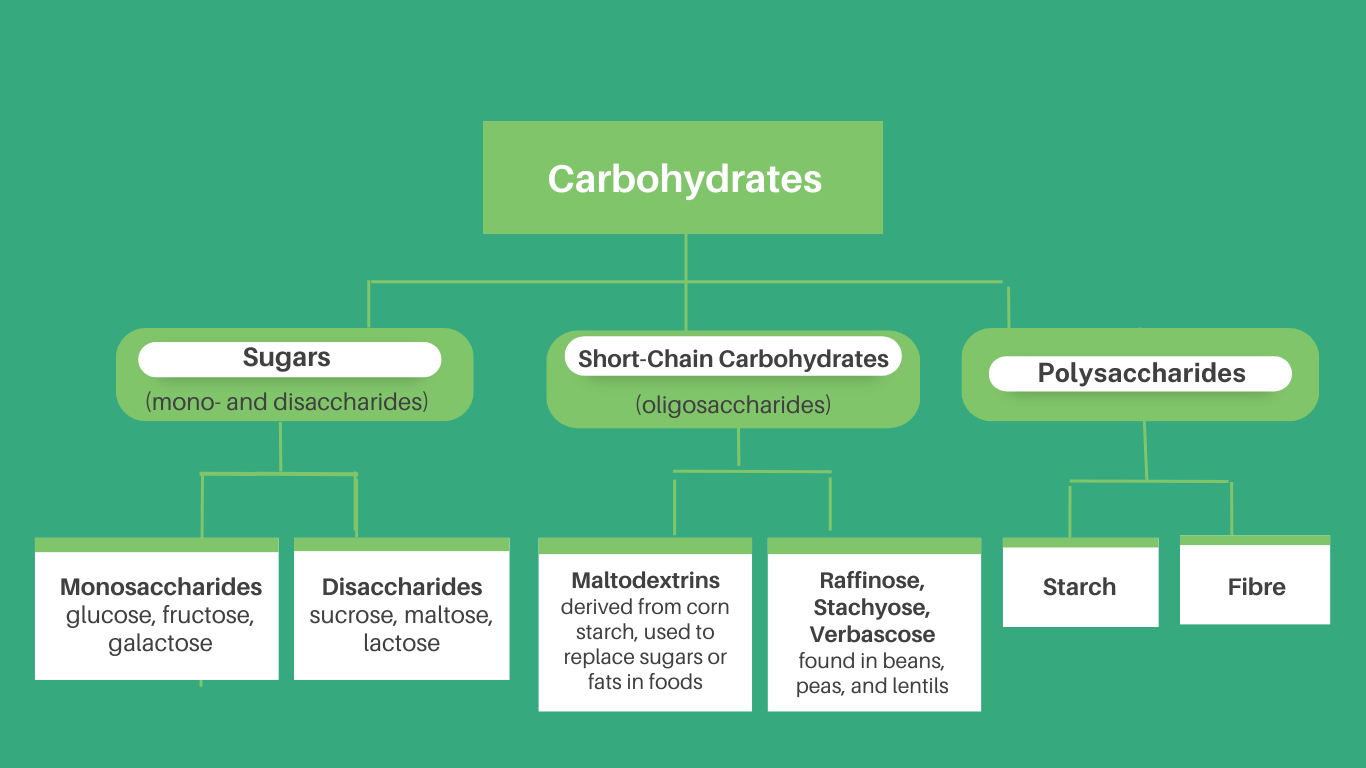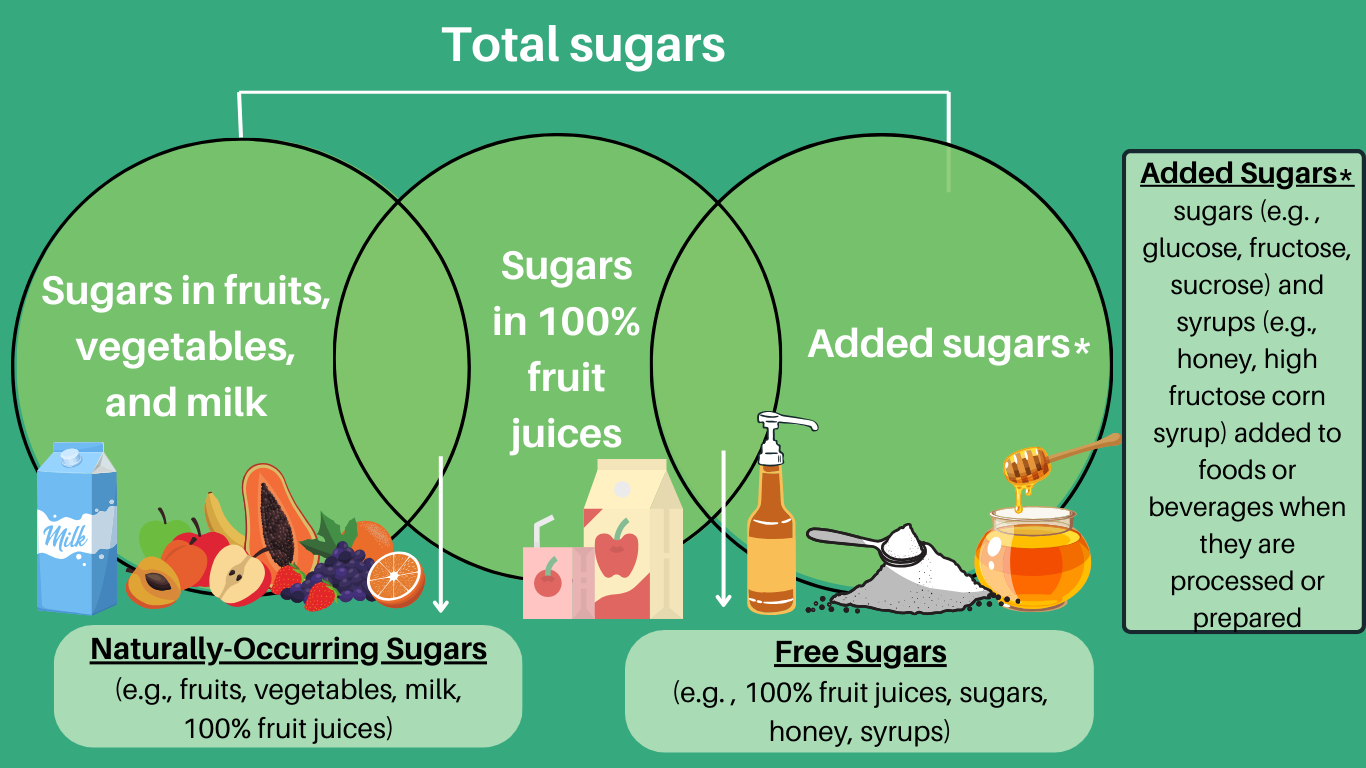There are many different terms when it comes to carbohydrates and sugars.
- Carbohydrates. Dietary carbohydrate include sugars, starches and fibres.
- Sugars. The term “sugars” describes all mono- and disaccharides. Sugars are found naturally in fruits, vegetables, and milk products, or added to foods and beverages.
- Sugar. The term “sugar” is used to describe sucrose specifically.
- Alternative sweeteners. "Sugars" does not include high-intensity sweeteners, sugar alcohols, or polydextrose.
Carbohydrates
Carbohydrates are an important source of food energy. Starches, sugars, and fibre are the most common types of carbohydrate in the diet.
Dietary carbohydrates can be grouped into three categories according to chemical composition and the number of single units that are bound together:
- Sugars (1-2 units);
- Short-chain carbohydrates or oligosaccharides (3-9 units); and
- Polysaccharides (at least 10 units).

During digestion, sugars (i.e. mono-saccharides and disaccharides), oligosaccharides and starch can all be broken down to single units by enzymes in the small intestine. They all provide 4 Calories per gram to the body. Fibres, on the other hand, cannot be broken down to single units. They are instead either fermented in the large intestine by microflora into other substances (e.g. short-chain fatty acids) or secreted out in feces intact. The fermentable fibres provide 2 Calories per gram to the body whereas infermentable fibres provide no Calories.
The compositions of common digestible carbohydrate are shown in the figure below..png)
Sugars
The term "sugars" or “total sugars” refers to all monosaccharides and disaccharides naturally occurring or added to foods. Examples of monosaccharides are glucose, fructose, and galactose, and examples of disaccharides include sucrose, lactose and maltose (see figure above). Sugars occur naturally in foods such as milk (lactose) and fruits and vegetables (glucose, fructose and sucrose). Sugars such as sucrose, honey, glucose and many others are also added to foods to provide sweetness and other important functional properties.
"Added sugars" refer to sugars (e.g. glucose, fructose, sucrose) and syrups (e.g. honey, high fructose corn syrup) that are added to foods or beverages when they are processed or prepared.
“Free sugars” is an emerging term appearing in recent government reports and dietary guidelines. It is defined by the World Health Organization and the UN Food and Agriculture Organization as sugars that are added to foods by the manufacturers or consumers, as well as naturally present in honey, syrups and fruit juices.

The source of the sugar does not affect its chemical make-up. For example, the sucrose extracted from sugar cane or sugar beet is chemically identical to the sucrose found in maple syrup, and all fruits and vegetables.
Sugar
“Sugar” is sucrose, a carbohydrate found in all fruits and vegetables, and the major disaccharide in most diets. All green plants produce sucrose through photosynthesis, the process by which plants transform sunlight into their food and energy supply. Some plants, such as sugar cane and sugar beet, accumulate high levels of sucrose and as such are used as commercial sources of sugar.
Sucrose is a disaccharide, made up of one unit of glucose and one unit of fructose. It is present in honey, maple syrup, fruits, berries, and vegetables, and is also added to food products in granular or liquid form. For more information about the sugars content of fruits, vegetables, and sweeteners, visit our page on Sources of Sugar.
In Canada, the Canadian Food Compositional Standards prescribe the standard for sugar as the "food chemically known as sucrose". This standard requires that sugar must "contain not less than 99.8% sucrose". For food labelling purposes, sugar is considered the "common name" of the food and must meet this standard. Compositional standards for other types of sugar are also defined, including icing sugar and brown sugar. All these products are derived from sugar cane or sugar beet.
For more detailed information on the labelling of sugars-based ingredients, visit our page on Nutrition Labelling and Claims.
Alternative Sweeteners
“Sugars” does not include high-intensity sweeteners, sugar alcohols, or polydextrose.
- High-intensity, zero-calorie sweeteners are food additives, and common examples include aspartame, acesulfame-potassium, and sucralose.
- Sugar alcohols are food additives, and common examples include erythritol, maltitol, sorbitol, and xylitol. Sugar alcohols are not completely absorbed in the small intestine and therefore contribute 0.2-3 Calories/gram compared to sugar’s 4 Calories/gram, however overconsumption can lead to bloating, diarrhea, and flatulence.
- Polydextrose is a food additive derived from dextrose (glucose), which is typically used to provide bulk in foods without adding sweetness. It contributes 1 Calorie/gram.
For more information, additional resources include:
- Infographic - Types of Sugars and Sweeteners
- Infographic - Learning About Sugars Labelling: New Nutrition Information
- Canada's Food Guide - Sugar Substitutes and Healthy Eating
- Health Canada July 2023 Update on Aspartame
Recent News Items Include:
- July 2023 - Health Canada Update on Use of Aspartame
References
- Government of Canada. Canadian Food Compositional Standards [Internet]. Government of Canada; 2025 May 1 [cited 2025 May 7].
- Cumming JH, Stephen AM. Carbohydrate Terminology and Classification. Eur J Clin Nutr. 2007;61:Suppl1: S5-S18.
- Report of a Joint FAO/WHO Consultation. Carbohydrates in Human Nutrition [Internet]. Food and Agriculture Organization; 1998 [cited 2024 Feb 21].


